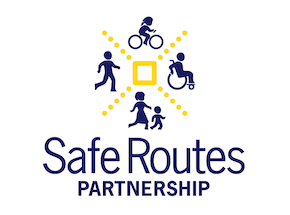In Los Angeles County, two years collaborative efforts to make sure the County’s transportation investments add up to create a truly multimodal system are at a critical juncture!
Resource Library
This policy statement highlights how the built environment of a community affects children’s opportunities for physical activity. Neighborhoods and communities can provide opportunities for recreational physical activity with parks and open spaces, and policies must support this capacity.
 "It is just not safe to let my child walk or ride their bike to school." So said respondents from the initial survey that the PTA of Linwood Elementary in Milwaukie, Oregon, sent out last spring. They didn’t know that 'Safe Routes to School' – with capital letters – existed. But they knew something was not right, and they wanted to fix it.
"It is just not safe to let my child walk or ride their bike to school." So said respondents from the initial survey that the PTA of Linwood Elementary in Milwaukie, Oregon, sent out last spring. They didn’t know that 'Safe Routes to School' – with capital letters – existed. But they knew something was not right, and they wanted to fix it.
More than 100 jurisdictions at the state, local, and regional levels have adopted Complete Streets policies. NPLAN has surveyed existing law, conducted extensive legal research, and consulted with legal and policy experts to create these model laws for Complete Streets.
 Just in time for International Walk to School Day, a new study has been published in the Journal of the American Planning Association that confirms what those of us in the field have long known: Safe Routes to School programs are effective at increasing rates of walking and bicycling to and from school.
Just in time for International Walk to School Day, a new study has been published in the Journal of the American Planning Association that confirms what those of us in the field have long known: Safe Routes to School programs are effective at increasing rates of walking and bicycling to and from school.
Each state DOT is required to develop a data-driven Strategic Highway Safety Plan for programming their Highway Safety Improvement fund. Some of this funding can be spent on bicycle and pedestrian safety for school children.
 As the new Congress convenes, pressure is on legislators to keep transportation dollars flowing. The current transportation law, MAP-21, expires in just four months in May 2015.
As the new Congress convenes, pressure is on legislators to keep transportation dollars flowing. The current transportation law, MAP-21, expires in just four months in May 2015.
Using California as a “meta case,” this research report establishes an empirical understanding of the full range of joint use and how specific strategies fit into a larger picture of more efficiently and appropriately utilizing public school spaces for educational and community purposes.
Can rural roads be good places to walk and bicycle? Why yes, they certainly can! My daughters got their first bicycles when they were five or six. They loved the bikes – but they couldn’t ride them. Because the streets in our small city were a little too busy for crazily uncoordinated families with bicycles and small children, we would drag ourselves, the girls, and the bikes over to the park every couple weeks. We would run around awkwardly holding the bicycle seats and trying to prevent the girls from crashing to the ground. While this did succeed in providing the whole family with
 Dedication. Passion. Commitment. These are all words that describe our Safe Routes to School champions across the nation, as evidenced not only by the great turnout for Bike to School Day but also by the increases we continue to see in bicycling and walking to school.
Dedication. Passion. Commitment. These are all words that describe our Safe Routes to School champions across the nation, as evidenced not only by the great turnout for Bike to School Day but also by the increases we continue to see in bicycling and walking to school.
This report summarizes discussion and findings from the 2005 National Summit on School Design.
 While the clock ticks quickly towards the July 31 expiration of transportation policy and funding, the Senate has been moving quickly (well, quickly for a legislative body that prides itself on a deliberative approach) to reach resolution.
While the clock ticks quickly towards the July 31 expiration of transportation policy and funding, the Senate has been moving quickly (well, quickly for a legislative body that prides itself on a deliberative approach) to reach resolution.
This website describes the initiatives of the Rural School and Community Trust, which is a national nonprofit working toward high-quality place-based education in rural settings through school and community connections.
 Since the first U.S. event in 1997, Walk to School Day has become the cornerstone annual event for champions of Safe Routes to School, walking and bicycling. Each year, Walk to School Day celebrations break records for participation, with more than 4,780 events being held in 2014. And in many communities, Walk to School Day events are just one part of a school’s efforts to embrace active lifestyles.
Since the first U.S. event in 1997, Walk to School Day has become the cornerstone annual event for champions of Safe Routes to School, walking and bicycling. Each year, Walk to School Day celebrations break records for participation, with more than 4,780 events being held in 2014. And in many communities, Walk to School Day events are just one part of a school’s efforts to embrace active lifestyles.
This summary document, drawn from a national dialogue among leaders in health andpublic education, with accompanying research, answers this question in the affirmative.
Catcalling, leering, whistling, persistently asking for a woman’s name as she walks down the street – these are all forms of street harassment. Street harassment happens every day. When people experience street harassment, they often shrug it off, unsure of how to respond and not wanting to make a big deal out of it. But street harassment is a form of harassment and can affect people’s comfort, stress, and behavior, whether they are conscious of it or not.
This guide is designed to help schools respond the the special nutrition concerns of low-income students in their wellness policies, including through increasing physical activity and recreational opportunities.
Today, the U.S. House of Representatives passed the Fixing America’s Surface Transportation Act (FAST Act), which is the final transportation agreement negotiated between the House and Senate. Once the Senate passes the agreement, expected by early next week, a new five-year transportation law will be in effect.
This paper explores the connection between home values andwalkability, as measured by the Walk Score algorithm.

